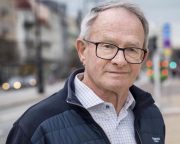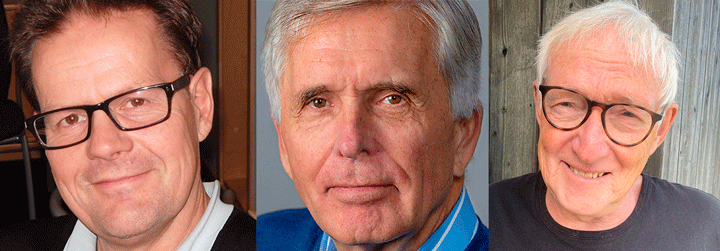CHRONICLE. Henrik Sjövall, Professor Emeritus of physiology and pathophysiology of the gastrointestinal tract, looks back at a long career and concludes that not everything was better in the past.

Sahlgrenska University Hospital advertises with the phrase “Best clinical research in the country” (image). Whether or not that is true really depends on how you measure it, but research is certainly now considered a natural part of work at Sahlgrenska. This workplace has around 1,000 clinicians with PhDs and nine out of ten want to stay and continue to conduct research while working at the hospital. It has become entirely natural to proudly describe a recently approved scientific project over coffee rather than more mundane matters.
Treacherous waters between research and health care
This was definitely not the case when I began my clinical training in the mid-80s. “Rat doctor” was not an entirely unusual epithet at that time, referring to people who had done their doctoral studies at preclinical institutions. They were never really taken seriously and perilous times lay ahead–the treacherous waters between research and medical care. I’ve now finally reached my port after that voyage, and I want to share the story of my travels. Not everything was better in the past; today that voyage is far simpler, because we now have a sea chart. It is called ALF.
I graduated with an undergraduate degree in medicine in 1975 and during my internal medicine training, I did my clinical internship at the allergy clinic Allergologen (Unit 5). That department was rather unusual; their mantra was – lo and behold – long periods of care! At that time, severe asthma attacks were treated with massive doses of cortisone and what was called an “asthma infusion,” containing an not entirely innocuous substance (theophylline) whose dose was changed daily, depending on the serum concentration. I remember the patients who were “marked by cortisone” with round faces, big bellies, and narrow legs. They occasionally died of their asthma.
That no longer seems reasonable

Assistant physicians were tasked with keeping records and going on rounds through the ward two days per week; the other days, they went on a “joint round” with the senior physician. One nurse (Sister Silva) did everything except strictly medical tasks. Most of the patients were asthmatics, but we also had an assortment of internal medicine cases. My favorite chief physician was Docent Hans Formgren; he was the kind of doctor I wanted to become: knowledgeable, good with patients, wise, and patient in his teaching. I was therefore very happily surprised when he offered me a summer position after that course, and naturally I accepted. That was probably the first crucial step in my path toward internal medicine, my future specialty. I remember that temporary position with some dread: while on call, you had a cardiac arrest alarm device, responsibility for all inpatients, and sole responsibility for emergencies during several hours in the morning. In addition to that, we were also responsible for medical consultations for Swedish ships at sea. For example: a sailor with chest pain, two days from the nearest port (Samoa…). It worked in in some way or other but that approach no longer seems reasonable today.
These kinds of extensive large-animal preparations are largely non-existent now

After the surgery course and several small courses, I was worn out and decided to take a break from studies. I had notified Ove Lundgren at Physiology of my interest in research, and I was considering trying out some research and combining that with a few more months of clinical work, followed by a very long trip. The allergy clinic had moved to Vasa hospital by then, and we served geriatrics at night with an on-call line. I remember that deaths at night were very common. You confirmed a death had occurred and wrote a few lines on the typewriter at the ward; the rest was handled during the day by the ward doctor. Otherwise, the allergy ward was the same, primarily handling “asthma infusions.”
I researched intestinal function in anesthetized lab test animals: cats, at that time, which were then euthanized. These kinds of extensive large-animal preparations are largely non-existent now. In terms of results, it went well enough–it felt like there could be a dissertation there. After a semester spent as a temp, combined with a very low-paying assistant position, I packed my backpack and headed to Asia for six months. At that time, this was relatively unusual and a bit daring; there were no cell phones if something happened. The trip was incredibly adventurous in a world that is essentially gone today, and so returning to ordinary student life again felt very nice.
The job at Physiology was poorly paid

I returned to my studies but also managed to conduct a great deal of research at Physiology, combined with occasionally being on-call at Vasa. When I graduated in 1980 with my medical degree, I decided to switch to full-time research with the goal of a doctoral dissertation. The job at Physiology was poorly paid (there were no doctoral positions at that time), so to support yourself, you had to “work.” At what was known at the time as Trollhättan Hospital, we were a group that kept the emergency room going. The long shift was 5:00 pm on Friday until 8:00 am on Sunday. The short shift was 8:00 am on Sunday until 8:00 am on Monday. After that, I got into our old Amazon and drove down to Gothenburg. We were well paid for that, but we were also productive; as a rule, two people could care for well over 100 patients a day. We had access to an X-ray machine, and we dealt with radius fractures, pulled on limbs, and put on casts. We received all kinds of patients, but not children under six months, cases obviously needing surgery, and difficult internal medicine cases, like heart attacks. We were also responsible for two surgical wards, where an on-call consultant came in for rounds on Saturdays and Sundays. Otherwise, we had to manage ourselves. At that emergency room, I learned rapid clinical diagnosis. We got to practice working with large volumes of patients, which was incredibly useful for me much later, when I worked at the Sahlgrenska emergency clinic.

I defended my thesis in 1984 and then–much to my surprise–I received a position as a postdoctoral research fellow at the Swedish Research Council. I had developed an allergy to lab animals, so I had to shift to human physiology, which in retrospect was a stroke of luck. I did my internship in Gothenburg and then went back and forth between the hospital and Physiology. During my internship, I worked with Lars Olbe at gastrosurgery and, with support from Lasse Fändriks, I began to study an odd motor programme called the migrating motor complex(MCC) in the stomach and duodenum. I did loads of work with method development. We discovered a rather bizarre phenomenon in which bicarbonate measured as carbon dioxide moved back and forth across the pylorus, a phenomenon that Hasse Abrahamsson at Medical Gastroenterology had also stumbled upon in his motor function studies. I connected the two projects and found (and corrected) a severe methodological error and the whole thing eventually became a couple of thesises.
Country doctor at Styrsö

Time passed, and soon enough I earned my medical license. What to do now? Purely by chance, on a walk I met Urban Brunell, head of the Styrsö GP Clinic, and I asked about a temporary position there. It turned out that one of his temps was about to quit, so I began working there part time. I was a “country doctor” at Styrsö two-and-a-half days each week. The rest of the week, I did research on the stomach at SU, funded by my postdoctoral research fellowship. For a while, I seriously considered becoming a general practitioner, but when they wanted to introduce a serfdom-like system, I opted out. I then spoke with Hasse Abrahamsson at Medical Gastroenterology. “Of course, you’re welcome to start as a substitute with us!” At the same time, I applied for and received a half-time research position at the Swedish Research Council, and during my specialist training, I went back and forth between methodologically demanding gut research and gradually an increasingly fleetfooted clinical position. At that time, I had a 52-hour work week + on-call duty, so I managed to see many patients, despite all that research.
Around the time the research position concluded, I also had completed my residency. Supported by Olle Isaksson, who, as per the norms of the day, was both head of the clinic and head of institute, I was given a combination professorship that I had until I retired. I once again left my comfort zone through a fascinating collaboration with biochemist and mucus researcher Gunnar Hansson, who is world-renowned in his field. My work consisted primarily of questioning some of his explanatory models, and I helped him initiate contact with clinics.
This remarkable journey ended with an honorary assignment
As you can see, it was a journey of twists and turns that could have ended up somewhere else entirely. If I may critically reflect on myself, I would probably say that I became neither a big clinician nor a major researcher, but I did hold a small Swedish Research Council grant for nearly thirty years. I had a wide-ranging life. I gradually became deputy head of institute, with teaching responsibility at the Institute of Medicine, and held the role of academic chair in the hospital administration for ten years. During the same period, I also worked to establish supplementary training for doctors trained abroad. I was involved with medical education in Nepal, and I evaluated new medical methods for Region Västra Götaland. These days, however, I am retired and have some (unpaid) hobby work, supervising projects for medical students. Over the years, I have supervised nearly a dozen students in a wide array of subjects, such as gastrointestinal bleeding, the mechanisms behind ethical stress, and the effects of literacy on health. This autumn, there were two projects in narrative medicine and in the spring, three students are going to Kathmandu to study sepsis, indications for lumbar puncture, and how to deal with unconsciousness of unknown etiology.

Lastly, as a final sounding of taps, this remarkable journey ended with an honorary assignment. A few months before I was going to step down, I had a talk with Jan-Ingvar Jönsson, secretary general at the Swedish Research Council. I knew him a little, since I had served as review panel chair for several years. I was in the middle of an endoscopy assignment when he called, so I asked him to call back. He wanted to know if I would lead a study of the support system for clinical research in Sweden. At first, I thought it was a misunderstanding: “You must have much better people available to you than me.” “Yes, yes, you would expect that” he responded, but then he said, “Whoever has the assignment must be good enough to not be scientifically questioned. They must understand clinical practice and be welcomed in the halls of power when it comes to health care. They must know a bit about preclinical work and have some familiarity with ‘big pharma’ and the world of entrepreneurs. And in all those cases, they must have no conflicts of interest. Many of the suggested names failed to meet some of those requirements, and in the end, you were the last man standing!”
You can’t turn down an invitation like that.
This one-time rat doctor is grateful for such an exciting journey
Together with Marika Greberg Hellqvist at the Office for Clinical Studies, I interviewed around three dozen people, “from castle to cottage: nobles, priests, merchants and farmers”.
Most of the suggestions in the study were approved. A committee in the support system was disbanded, another committee was reinforced in a major way, and, above all, a new general secretariate was created, with specific responsibility for clinical research. And finally, together with two key collaborators (Johan Brun and Boo Edgar), I have just written an op-ed piece about our study in Läkartidningen, subtitled “Sweden can retake a leading position in clinical research–if we want to.”

This one-time “rat doctor” is grateful for an exciting journey and hopes that more medical students will choose to take a similar one. These days, building a career is indeed much less adventurous. There are plenty of training positions that combine clinical and scientific education (ALF/internship, ALF/specialty training, higher clinical research positions and more).
One thing I can assure any aspiring candidates: there is never a boring moment when traversing the remarkable waters between two of the world’s most fascinating jobs.
P.S. And who knows? I may have another short column in me waiting to be written. Never say never again!












